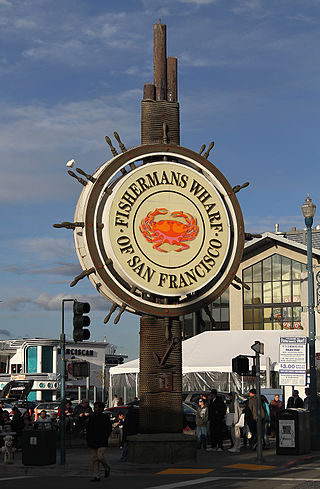Related Research Articles

Skidmore, Owings & Merrill (SOM) is an American architectural, urban planning and engineering firm. It was founded in 1936 by Louis Skidmore and Nathaniel Owings in Chicago, Illinois. In 1939, they were joined by engineer John Merrill. The firm opened its second office, in New York City, in 1937 and has since expanded internationally, with offices in San Francisco, Los Angeles, Washington, D.C., London, Melbourne, Hong Kong, Shanghai, Seattle, and Dubai.

The Ghirardelli Chocolate Company is an American confectioner, wholly owned by Swiss confectioner Lindt & Sprüngli. The company was founded by and is named after Italian chocolatier Domenico Ghirardelli, who, after working in South America, moved to California. The Ghirardelli Chocolate Company was incorporated in 1852, and is the third-oldest chocolate company in the US, after Baker's Chocolate and Whitman's.

Fisherman's Wharf is a neighborhood and popular tourist attraction in San Francisco, California. It roughly encompasses the northern waterfront area of San Francisco from Ghirardelli Square or Van Ness Avenue east to Pier 35 or Kearny Street. The F Market streetcar runs through the area, the Powell-Hyde cable car line runs to Aquatic Park, at the edge of Fisherman's Wharf, and the Powell-Mason cable car line runs a few blocks away.
A festival marketplace is a European-style shopping market in the United States. It is an effort to revitalize downtown areas in major US cities begun in the late 20th century.

Ghirardelli Square is a landmark public square with shops and restaurants and a 5-star hotel in the Marina area of San Francisco, California. A portion of the area was listed on the National Register of Historic Places in 1982 as Pioneer Woolen Mills and D. Ghirardelli Company.

The Letterman Digital Arts Center (LDAC), is an institution located in the Presidio, San Francisco, that has served as the combined home of Industrial Light & Magic, LucasArts, and Lucasfilm's marketing, online, and licensing units since 2005.
Adaptive reuse refers to the process of reusing an existing building for a purpose other than which it was originally built or designed for. It is also known as recycling and conversion. Adaptive reuse is an effective strategy for optimizing the operational and commercial performance of built assets. Adaptive reuse of buildings can be an attractive alternative to new construction in terms of sustainability and a circular economy. It has prevented thousands of buildings' demolition and has allowed them to become critical components of urban regeneration. Not every old building can qualify for adaptive reuse. Architects, developers, builders and entrepreneurs who wish to become involved in rejuvenating and reconstructing a building must first make sure that the finished product will serve the need of the market, that it will be completely useful for its new purpose, and that it will be competitively priced.

Willis Jefferson Polk was an American architect, best known for his work in San Francisco, California. For ten years, he was the West Coast representative of D.H. Burnham & Company. In 1915, Polk oversaw the architectural committee for the Panama–Pacific International Exposition (PPIE).
Oakland City Center is an office, shopping and hotel complex in Downtown Oakland, Oakland, California. The complex is the product of a redevelopment project begun in the late 1950s. It covers twelve city blocks between Broadway on the east, Martin Luther King Jr. Way on the west, Frank H. Ogawa Plaza on 14th Street on the north side of the complex and the Oakland Convention Center and Marriott Hotel extend south to 10th Street. An hourly parking garage is located beneath the complex's shopping mall. The mall features an upscale fitness and racquet club, in addition to numerous take-out restaurants and other stores. The complex is served by the 12th Street/Oakland City Center BART station.

Old Oakland is a historic district in downtown Oakland, California. The area is located on the northwest side of Broadway, between the City Center complex and the Jack London Square district, and across Broadway from Chinatown.

The Emporium, from 1980 to 1995 Emporium-Capwell, was a mid-line department store chain headquartered in San Francisco, California, which operated for 100 years—from 1896 to 1996. The flagship location on San Francisco's Market Street was a destination shopping location for decades, and several branch stores operated in the various suburbs of the Bay Area. The Emporium and its sister department store chains were acquired by Federated Department Stores in 1995, and many converted to Macy's locations.

Downtown Richmond is the old center of Richmond, California. The area is roughly bordered by 6th street to the west, 23rd Street to the east, Barrett Avenue to the north, and Macdonald Avenue to the south. The area once featured major department stores and other chains such as J.C. Penney, Macy's, S. H. Kress & Co., and Sears before Hilltop Mall was built in the 1970s.The area is currently undergoing a revitalization effort by the city, which has included the Richmond Shopping Center anchored by a supermarket. The Richmond Transit Village—coined Metro Walk by the developers, the Olson Company—has also been built, along with remodeling of the Richmond BART and Amtrak station and a bus transit center served by AC Transit and Golden Gate Transit. A Kaiser Permanente hospital and a Social Security Administration processing center provide for a majority of the jobs in the area.
Peter Tolkin + Sarah Lorenzen Architecture (TOLO), formerly Peter Tolkin Architecture, is an architectural firm based in Los Angeles, California, established in 1998.

Architectural Resources Group is a firm that was founded in 1980 by Bruce Judd and Steve Farneth in San Francisco, CA. It began by providing professional services in the fields of architecture and urban planning with particular expertise in the area of historic preservation. In 2000, David Wessel, a Principal of ARG, founded a separate conservation-contracting division, ARG Conservation Services which operates under the same roof as ARG. By 2005, the firm had expanded to a full-service architecture firm with 50+ employees. ARG also opened offices in Pasadena serving Southern California, and Portland, Oregon, serving the Pacific Northwest.

Beverly Willis is an American architect who played a major role in the development of many architectural concepts and practices that influenced the design of American cities and architecture. Willis' achievements in the development of new technologies in architecture, urban planning, public policy and her leadership activities on behalf of architects are well known. Her best-known built-work is the San Francisco Ballet Building in San Francisco, California. She is the co-founder of the National Building Museum, in Washington, D.C., and founder of the Beverly Willis Architecture Foundation, a non-profit organization working to change the culture for women in the building industry through research and education.
MBH Architects is an architecture and interior design firm founded in October 1989 by architects John McNulty and Dennis Heath. The firm is headquartered in a LEED Gold certified office in Alameda, California in the San Francisco Bay Area.
COOKFOX Architects is a firm of architects founded by Rick Cook and Robert F. Fox, Jr. in 2003. The firm works on both new projects and on the adaptive reuse of existing buildings. COOKFOX is best known for designing the Bank of America Tower at One Bryant Park.

ROMA Design Group is an interdisciplinary firm of architects, landscape architects, and urban planners based in San Francisco, California, USA. It was founded in 1968 by American architect George T. Rockrise.
Marmol Radziner is a design-build practice based in Los Angeles that was founded in 1989 by American architects Leo Marmol and Ron Radziner. The firm specializes in residential, commercial, hospitality, cultural, and community projects, and offers various design services, including architectural design, construction, landscape design, interior design, furniture design, jewelry design, and modern architecture restoration.

Bayfair Center is a regional shopping mall and power center in San Leandro, California. It was among the first malls in the East Bay of the San Francisco Bay Area. Anchor stores are Macy's, Target, Kohl's, Staples, Old Navy, PetSmart, Bed Bath & Beyond, Cinemark, and 24 Hour Fitness.
References
- ↑ Thomas, Lynn (October 1973). "Restored Commercial Buildings: How the City Saves Face". San Francisco Business. p. 24.
- ↑ Lorenz, Clare (1990). Women in architecture : a contemporary perspective (1. publ. in the USA. ed.). New York: Rizzoli. pp. 134. ISBN 9780847812776.
- ↑ "Success by Her Own Rights". San Francisco Business. August 1984. p. 25.
- ↑ Marlin, William (April 1973). "The Streets of Camelot". The Architectural Forum: 29.
Coordinates: 37°47′53″N122°25′49″W / 37.79792°N 122.4303°W